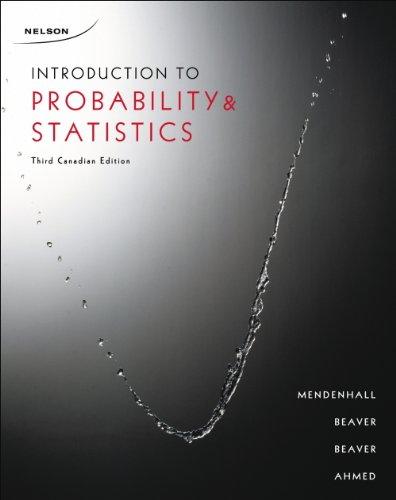Boreal mixedwood forests have been commercially logged for conifers, transected by roads and seismic cutlines, and regionally
Question:
Boreal mixedwood forests have been commercially logged for conifers, transected by roads and seismic cutlines, and regionally fragmented by agricultural practices. Most recently, Alberta's public mixedwood forests have been allocated for harvest of trembling aspen for pulp, paper, and oriented strand board products. With relevance to commercial forestry, this report describes the structure and biodiversity of aspen- dominated mixedwood forests of fire origin. The boreal mixedwood forest in Canada extends from southwestern Manitoba, through the central and northern parts of the prairie provinces, and into northeastern British Columbia. A scientist is studying the relationship between x = diameter at breast height (DBH) (in centimetres) of aspen mixedwood forest in Alberta and y = canopy height (in metres). The data are as follows.
![]()
a. Develop a scatterplot for these data.
b. What does the scatterplot developed in the previous question indicate about the relationship between the two variables?
c. Calculate the correlation coefficient r. Is there a significant positive correlation between x and y? Perform an appropriate statistical test.
d. Use a statistical software package of your choice and report the regression analysis results.
e. What is the equation of the least-squares regression line?
f. What is the average change in canopy height with an increase of one centimetre in DBH? g. How do you describe the strength of the relationship between y and x? h. Find and interpret the coefficient of determination. i. What percentage of the total variation in y can be explained by the simple linear regression model? j. Is the simple linear regression model useful for predicting the canopy height of the trees from a given diameter in breast height of the trees? Use the p-value approach to test the usefulness of the linear regression model at the 0.05 level of significance. k. Use the F test to test the hypotheses Ho: B=0 vs. H.: B=0 at a = 0.05. 1. Compare the two-tailed critical value at a = 0.025 for the test with the critical value for the F statistic at a = 0.05. What is the relationship between the two values? m. Predict the tree canopy height of a 42-centimetre diameter at breast height. n. Would you use the least-squares prediction equation line to find the estimated can- opy height for a diameter at breast height of 52 centimetres? Why or why not? o. Find a 95% confidence interval for the slope of the line. p. Estimate the change in canopy height for a 1-unit change in diameter at breast height. Use a 99% confidence interval. Compare this interval with the interval in part o.
q. What is the best estimate of the common population variance o? r. Use the predicted values and the actual values of y to calculate the residuals. s. Plot the residuals against the predicted values . Does it appear that the constant variance regression assumption has been violated? Explain. What conclusion, if any, can be drawn from the plot? t. Draw a histogram of the residuals. Does it appear that the errors are normally dis- tributed? Explain. u. Use the residuals to compute the standardized residuals. v. Do there appear to be any outliers in the data? Justify your answer. w. Consider the normal probability plot of the residuals. What conclusion can be drawn from the plot? x. Find a 95% confidence interval for the mean value of y (canopy height) when diam- eter at breast height is 10. y. Compute a 95% prediction interval for the canopy height when diameter at breast height is 10. z. Which interval in the previous two questions is narrower: the confidence interval estimate of the expected value of y or the prediction interval of y for the same given value of x (10 centimetres) and same confidence level? Why?
Step by Step Answer:

Introduction To Probability And Statistics
ISBN: 9780176509804
3rd Edition
Authors: William Mendenhall





